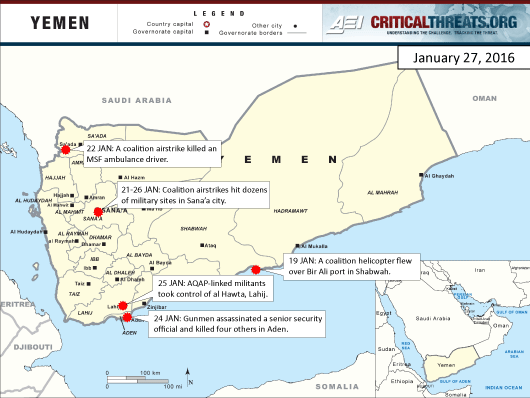Al Qaeda in the Arabian Peninsula (AQAP) may be expanding the areas under its control into Lahij governorate, north of Aden. The coalition may attempt to limit AQAP’s growth, but is unlikely to challenge AQAP’s safe havens while remaining entrenched in the anti-al Houthi fight.
Islamist militants possibly linked to AQAP seized control of a city within kilometers of key coalition sites. The militants took control of government buildings and other areas in Lahij’s regional capital al Hawta on January 25, blowing up a police station and establishing roadside checkpoints in the process. The militants also blew up a “deviant” woman’s house, a tactic that is not a signature of AQAP. This group likely is linked to the militants who briefly took control of al Hawta in March 2015 and were labeled as Ansar al Sharia, AQAP’s insurgent arm, at the time. Al Hawta is only about 40 kilometers from Yemeni President Abdu Rabbu Mansour Hadi’s de facto capital in Aden and only 10 kilometers from al Anad airbase, a strategic military base for pro-Hadi military operations. Coalition-backed forces pushed al Houthi-Saleh troops out of Lahij in March 2015. The return of Salafi-jihadi militants to al Hawta underscores the coalition-backed government’s limited control in Yemen. If the group is linked to AQAP, it also marks a westward expansion of AQAP’s zone of control, which extends through Abyan, parts of al Bayda and Shabwah, and into Hadramawt.
Continued reporting indicates the Saudi-led coalition may be wary of AQAP’s expansion. There are reports that a coalition helicopter flew over Bir Ali port in Shabwah on January 19, possibly surveilling the port. This sortie accompanies a new but sustained naval blockade of the port in al Mukalla, Hadramawt, AQAP’s chief stronghold and a key transit point for smuggling, and the closure of the two Omani border crossings into Yemen. It is unlikely that the coalition will begin ground operations against AQAP at this time as its forces remain committed along the western and northern fronts. The bulk of the coalition’s air and naval resources remain deployed against the al Houthi-Saleh forces, but it is possible that the coalition will attempt to disrupt some of AQAP’s operations.
AQAP appears to be winning the propaganda war against ISIS in Yemen. A January 15 AQAP video featured a defected Islamic State in Iraq and al Sham (ISIS) in Yemen “leader” apologizing to al Qaeda leader Ayman al Zawahiri and rejecting ISIS’s brand of Islam. The militant denounced ISIS members as Kharijites, a militant, heretical movement from 7th century Islam, and criticized the group for killing Muslims. Zawahiri described the group as worse than the Kharijites in a January 14 statement. (Translation obtained from SITE.) AQAP will continue compete with ISIS in Yemen for recruits, though it is likely AQAP will remain the dominant Salafi-jihadi group in the country.
Security challenges in Aden continue to damage the Hadi government’s legitimacy. A string of assassination attempts continued in Aden, following weeks of killings by local militant groups. Gunmen killed a senior security official and four others in Aden on January 24, and unsuccessfully targeted a UAE military convoy the day before. The Director of Criminal Investigations in Aden escaped a car bomb attack in the al Ayadat area in Aden, one week after a similar assassination attempt on Aden’s police chief. Local actors will continue to destabilize Aden and undermine the Hadi government’s efforts to establish itself as Yemen’s future unity government.
The UN Panel of Experts report on Yemen described widespread airstrikes on civilian targets. The UN report alleged that al Houthi-Saleh forces as positioning themselves within residential areas and using civilians as shields. It also attributed 60 percent (2,682) of the civilian casualties to air-launched explosive weapons. Coalition airstrikes continued in Sana’a and northern Yemen this week as al Houthi forces resumed cross-border attacks on Saudi Arabia. Coalition airstrikes hit dozens of targets in Sana’a and Sa’ada, as well as Ma’rib, killing a Doctors Without Borders ambulance driver in Sa’ada in the process. Al Houthi forces clashed with Saudi border guards in Jazan and Najran districts in Saudi Arabia during January 25 border raids. Border attacks on Saudi Arabia will draw the coalition further into the conflict in northern Yemen.
AQAP will continue to strengthen as the Yemen conflict protracts, though there are indicators that the coalition may be seeking to prevent additional gains. An entrenched AQAP poses existential threats to a future Yemeni state and provides the al Qaeda network with a strategic base, threatening long term U.S. security.
Jon Diamond contributed research to this piece.

